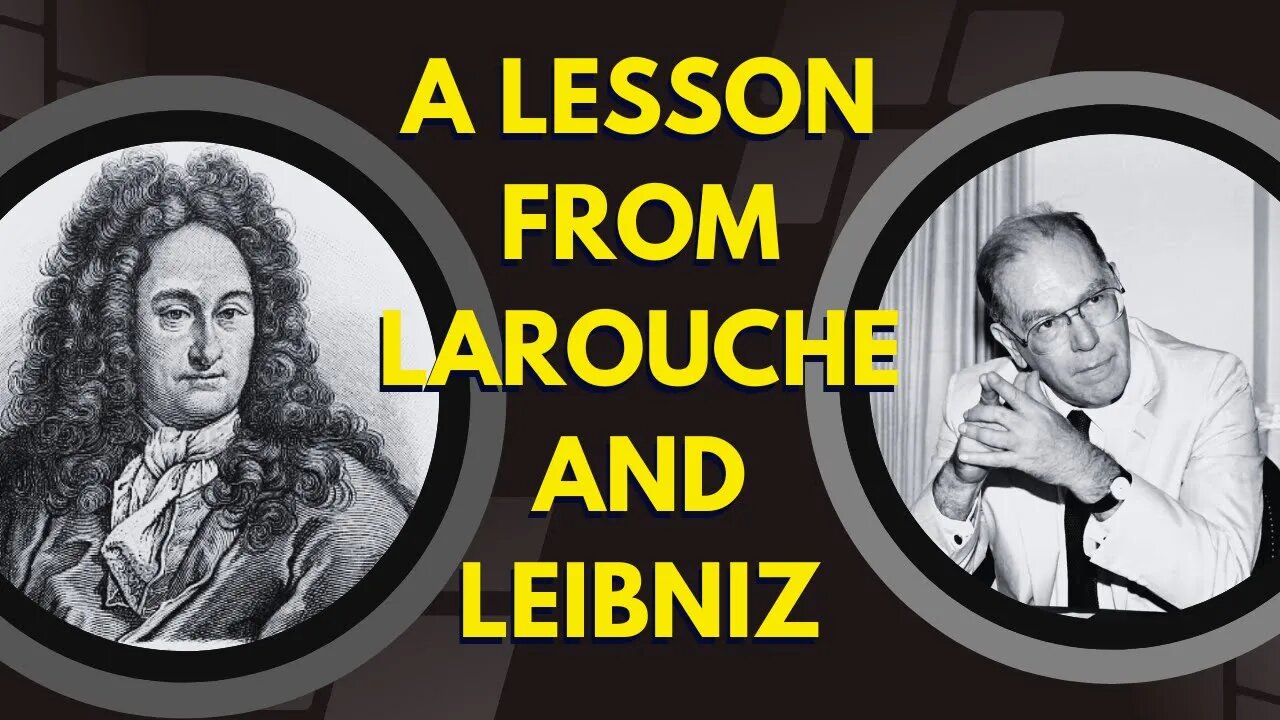Premium Only Content

Living a Thousand Lives in One: A Lesson from LaRouche and Leibniz
Dennis Small delivers a presentation to a Cadre School July 15, 2023.
Excerpted from Lyndon LaRouche's paper, "MY EARLY ENCOUNTER WITH LEIBNIZ: On Monadology." Read the complete paper here: https://larouchepub.com/eiw/public/2008/eirv35n08-20080222/eirv35n08-20080222_026-my_early_encounter_with_leibniz-lar.pdf
My first significant, and lasting encounter with the work of Gottfried Leibniz, erupted in the context of my adolescent years' virtual "guerrilla war" against the cult of Euclidean geometry. This eruption occurred during the interval between my fourteenth and fifteenth years. Leibniz's Monadology, albeit read by me then in translations into English, was the first work to which I became seriously and permanently attached on this account, as if attached to something which I began to recognize then as encompassing the entirety of myself.
This was the subject which occupied most of the pages of my scribbles deposited into those high school recess-periods' notebooks which I filled out during those years. It was the Monadology whose specific mode of argument gripped me for reason of its relevance to my already established rejection of what passed for the teaching of Euclidean Plane Geometry, as later, of Solid Geometry, and, still later, of so-called Cartesian ("Analytic") Geometry, and, then, the perverted, Cauchy version of the Differential Calculus.
As I have publicized fragments of reports on this subject, scattered among sundry lectures and published writings over the course of, especially, the recent four decades: my rejection of Euclid, at my first classroom encounter with that dogma, reflected conclusions which I had reached in study of constructions which I had observed earlier, at Boston's Charlestown Navy Yard. At that Navy Yard, I had been struck by the way in which structural beams were crafted to the purpose of increasing the ratio of the weight of the supporting aspects, to total weight of structures supported, supported so, by the manner chosen for the shaping of supporting beams and its structure as a whole.[2]
Guided by my memory of that important experience I had enjoyed at the Navy Yard, I left the first hour spent in that geometry classroom on the first day of geometry class, correctly convinced that the reductionist method employed by adoption of Euclid's so-called a priori definitions, axioms, and postulates, was essentially (e.g., axiomatically) wrong. This conviction grew into becoming my later years' recognition that the origin of Euclid's hoax was to be located in the influence of the Sophist Aristotle on his relevant follower, Euclid.
It was the foregoing experience which had prompted my virtually allergic rejection of my subsequent high school and university experience of the teaching of Analytic Geometry, and, later, my mind's refusal to tolerate the axiomatic, reductionist assumptions taught (to me) as Differential Calculus at the university undergraduate level. This evidence prompted that same seemingly allergic reaction against a Differential Calculus consistent with the dogmas of Laplace and Cauchy. My happier, although soon interrupted, war-time experience with certain aspects of a course which was taught as Integral Calculus, during classes held at the university during the Autumn of 1942, provided, albeit briefly, unfortunately, at that time, a strong affirmation of the viewpoint which I had adopted some years earlier. This produced my recognition of the need for a truly Leibnizian calculus which would be based specifically on a fully conscious, efficient rejection of the axiomatically reductionist, Sophist, Aristotelean model of Euclid.
It was this same accumulated experience from the 1936-1942 interval, which provoked what proved later to have been my post-war, 1946-47 reaction to the writings of such topics as those damnably reductionist views of such criminals as Aristotle and Euclid on the categorical subject of life. Already, then, I saw life clearly as being necessarily an ontologically specific mode of existence, as in my short-lived attraction to the work of Pierre Le Comte du Noüy, and my subsequent, 1948 reaction against the radically reductionist[3] pollution expressed by Professor Norbert Wiener's cultish quackery of "information theory." Thence, I was led, by 1953, from reflections on the essential folly of "information theory," to the adoption of the standpoint of Bernhard Riemann's 1854 habilitation dissertation: a Riemann work whose opening two printed pages had then already sufficed, for what should be recognized as obvious reasons, to touch and excite my soul, then, as in the preparation of this present writing, today.
-
 LIVE
LIVE
The Rubin Report
54 minutes ago‘Piers Morgan’ Goes Off the Rails as 'TYT' Host Attacks Dave with Nasty Insults
2,983 watching -
 1:47:50
1:47:50
Steven Crowder
1 hour agoLWC Christmas Special 2024 | Giving Back with Santa Crowder
19.6K117 -
 2:19:25
2:19:25
Matt Kohrs
10 hours agoMarket Chaos || The MK Show
33K3 -
 LIVE
LIVE
LFA TV
12 hours agoDING DONG THE BILL IS DEAD! | LIVE FROM AMERICA 12.19.24 11am EST
4,305 watching -
 37:31
37:31
BonginoReport
5 hours agoShut It Down (Ep.108) - 12/19/2024
56.9K203 -
 LIVE
LIVE
Vigilant News Network
16 hours agoBUSTED: ‘The View’ Co-Host May Face Criminal Investigation | The Daily Dose
1,570 watching -
 2:02:09
2:02:09
Film Threat
14 hours agoSUPERMAN TRAILER LIVE REACTION | Film Threat Livecast
34.9K5 -
 47:27
47:27
PMG
11 hours ago $0.09 earned"Hannah Faulkner and Jeremy Harrell | LIVE FROM AMERICA!!!"
339 -
 1:03:14
1:03:14
2 MIKES LIVE
2 hours agoTHE MIKE SCHWARTZ SHOW with DR. MICHAEL J SCHWARTZ 12-19-2024
29.1K4 -
 4:45
4:45
Gamazda
15 hours ago $12.95 earnedGuns N' Roses - Sweet Child O' Mine
59.4K50